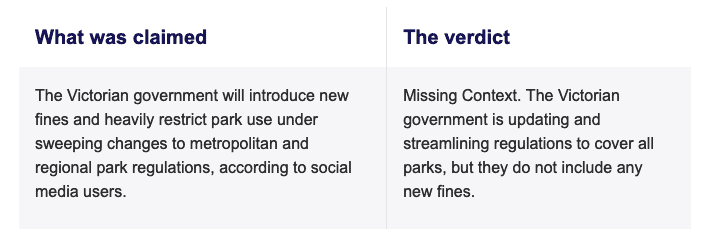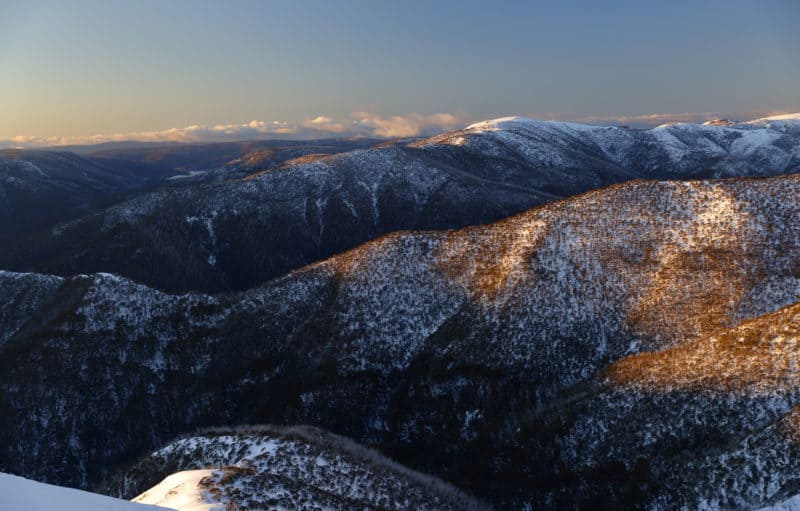RMIT FactLab has reviewed false claims promoted online about new fines for park goers in Victoria’s regional and metropolitan parks.
Page updated: 08/11/2022
NEWS 12 October 2022 |
There’s a lot of misinformation circulating about proposed new regulations for Victoria’s regional and metropolitan parks. We’ve unpacked this scare campaign to demonstrate that, really, there is nothing to be scared about.
Under state law regulations are needed to enforce the law under which land is covered and to manage visitor pressure and behaviour to protect the environment as well visitor safety and enjoyment.
These regulations are completely routine – successive governments of all political flavours have put them in place in various forms for decades. They play a key role in managing visitor pressure and protecting the natural environment, and local wildlife.
Earlier this year the Department of Land, Water and Planning (DELWP) released proposed regulations for Regional and Metro Parks covered under the Crown Land (Reserves) (Metropolitan and Regional Parks) Regulations (proposed regulations).
These regulations have not kept up with technological changes such as drones and e-bikes, and are set to expire on 31 March 2023. The new regulations will align with other laws that protect Aboriginal heritage, wildlife and help manage issues such as animal welfare, and firewood and plant poaching on public lands.

Both metro and regional parks are not part of the protected areas estate, and have a lower level of protection and so are managed differently to national parks. They, however, still hold conservation values and critical habitat for Victoria’s plant life and wildlife.
What are regional parks?
Regional parks are defined as extensive areas of natural or semi-natural land close to population centres or major tourist routes or easily accessible areas.
What are metropolitan parks?
Metropolitan – or metro – parks are large state-run parks in Melbourne like Albert Park, Jells Park. Yarra Bend, Wattle Park.
These are public parks providing open space for recreation largely established by the Melbourne Metropolitan Board of Works. They can include natural or semi-natural environments to highly modified areas. Since the 1990s metro parks have been managed by Parks Victoria.
We’ve fact checked the misconceptions about the proposed regulatory changes – check them below.
Existing arrangements for fishing access and fishing in metropolitan parks will not be affected by the proposed regulations.
The proposed regulations will limit swimming in metropolitan parks, subject to the land manager setting aside areas where swimming is allowed.
Swimming in certain areas is not always appropriate due to other water body uses such as boating and rowing or poor water quality that could cause harm to human health.
Dogs will still be allowed in the majority of metro and regional parks when under the control of their owner at all times (on leash), and in areas set aside where dogs are permitted.
Dogs will not be allowed in the following areas (unless the land manager has set aside areas dogs are permitted);
– Altona Natural Features Reserve (unless on a leash and restrained from leaving the path on Skeleton Creek Trail)
– Dandenong Ranges Botanic Garden
– Gabo Island Lighthouse Reserve
– Point Cook Coastal Park (unless on leash and restrained from leaving the path on the Bay Trail)
– Point Hicks Lighthouse Reserve
– Werribee Park
– William Ricketts Sanctuary, Mt Dandenong
Dogs are not permitted in these areas due to the negative impact their smells, sounds (barking) and presence has on local wildlife (such as Superb Lyrebirds, Hooded Plovers and Bandicoots in the above areas), or the impact they have on the amenity, enjoyment, or safety of other park users (such as at Werribee Park).
This is nothing unusual local council impose similar restrictions and planning for local parks.
Always look for signage at the entrances of parks and reserves as to whether dogs are permitted in the area and possible conditions of entry such as being on lead and picking up of dog poop being required.
Under the proposed regulations rocks or natural features cannot be “excavated, removed, destroyed, damaged or defaced.” This is a standard regulation across many areas of public land and is warranted for a range of reasons.
These reasons include the maintainence of public amenity of the areas, protection of creeks and rivers and water quality, protection of wildlife habitat, as well as protection of Aboriginal cultural heritage sites.
Native and often endangered wildlife, like the Striped Legless Lizards and other reptiles, rely on rocks as their homes. Activities such as rock excavation and stacking can kill and disturbed them..
You can read more here about the harm caused by rock stacking.
In order to balance the use of these areas, some activities need to be excluded from specific places. For example, an area set aside with barbeques and tables would be inappropriate site for a footy match or large event as it would reduce the amenity of the area by other park users.
These regulations help land managers balance the needs, safety and amenity of the parks for all park users. Regulations help with enforcement of these zoning areas as well as a clarity of what is permitted in particular areas and ensure land managers have control over large events through permits.
Sticking to defined and identified tracks is important for a range of reasons. This includes:
– Reducing the spread of pathogens (such as Phytophthora cinnamomi that kills native vegetation)
– The erosion of sensitive parts of the landscape
– Impacts on local water ways, native vegetation an habitat
– The protection and care of aboriginal cultural heritage sites.
This is a standard regulation for our parks and helps manage the growing numbers of visitors and helps lessen the impacts of recreation on our parks and waterways.
In many case the regulations serve as a back stop, often used in conjunction with park management or master plans all so the right activity can happen in the right place.
Firewood must only be collected from designated areas in state forests, and sometimes within regional park areas (during selected periods of times and seasons). A list of these places can be found here .
Always check with the local land manager before taking firewood. The proposed regulations are a standard rule across all public land. Firewood poaching causes great harm to our parks by removing habitat for wildlife, damage to understory vegetation from tree felling and damages our parks.
The community can report suspected illegal cutting or removal of firewood anonymously by calling 136 186.
You can read more here from the Office of the Conservation Regulator on how to purchase firewood from legal sources
Want to be kept up to date about this and other nature issues in Victoria? Subscribe to our email updates.

